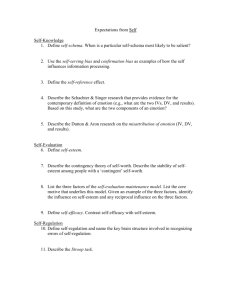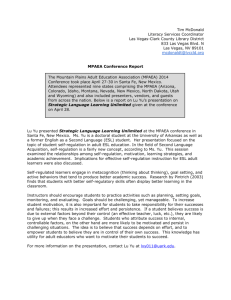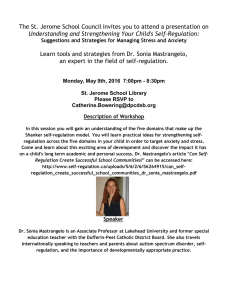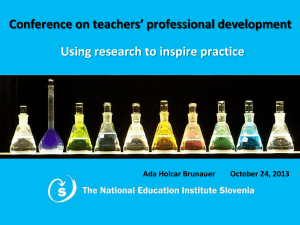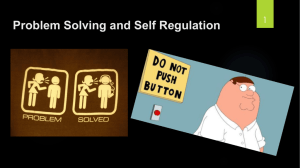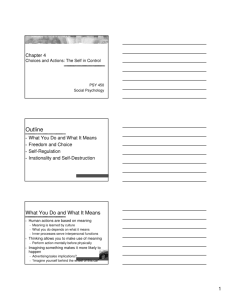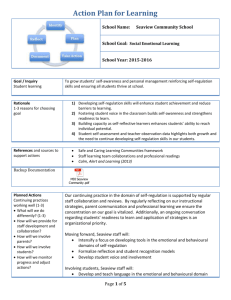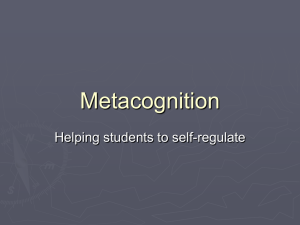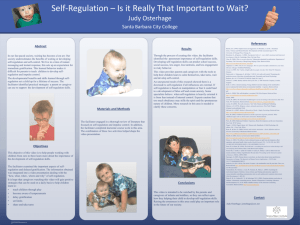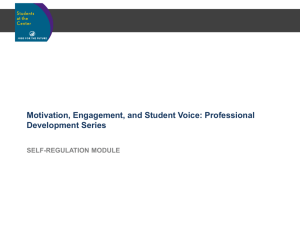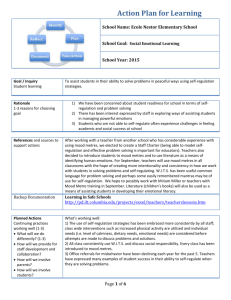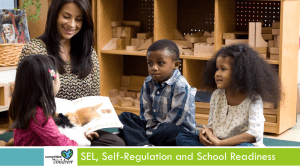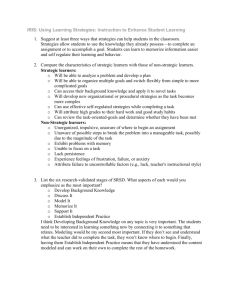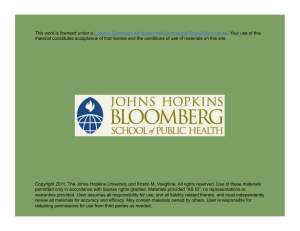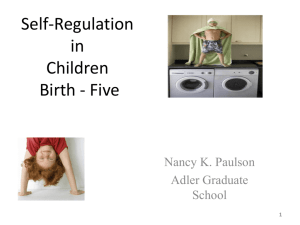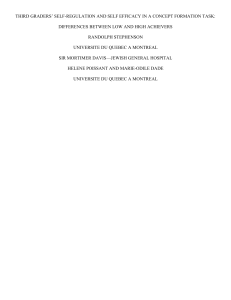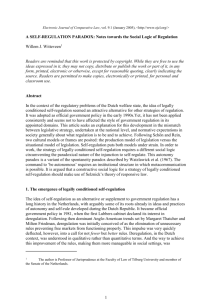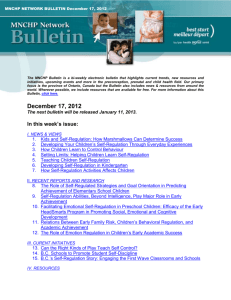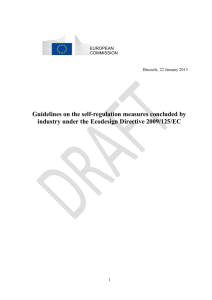APL Coquitlam River 2015-16
advertisement
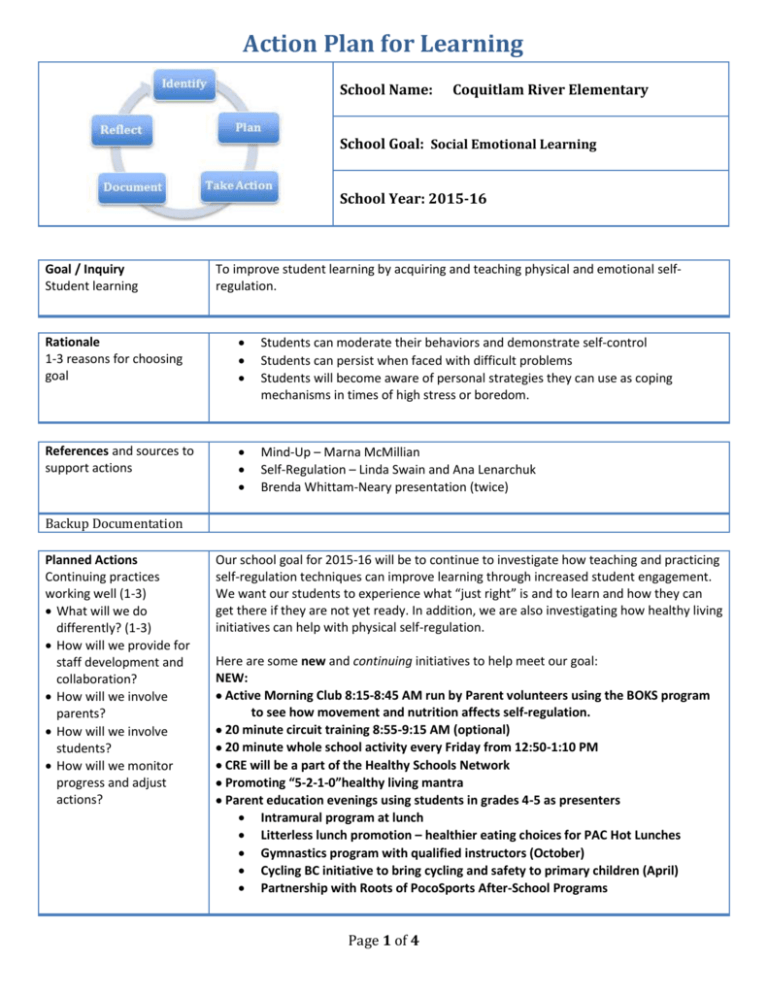
Action Plan for Learning School Name: Coquitlam River Elementary School Goal: Social Emotional Learning School Year: 2015-16 Goal / Inquiry Student learning To improve student learning by acquiring and teaching physical and emotional selfregulation. Rationale 1-3 reasons for choosing goal Students can moderate their behaviors and demonstrate self-control Students can persist when faced with difficult problems Students will become aware of personal strategies they can use as coping mechanisms in times of high stress or boredom. References and sources to support actions Mind-Up – Marna McMillian Self-Regulation – Linda Swain and Ana Lenarchuk Brenda Whittam-Neary presentation (twice) Backup Documentation Planned Actions Continuing practices working well (1-3) What will we do differently? (1-3) How will we provide for staff development and collaboration? How will we involve parents? How will we involve students? How will we monitor progress and adjust actions? Our school goal for 2015-16 will be to continue to investigate how teaching and practicing self-regulation techniques can improve learning through increased student engagement. We want our students to experience what “just right” is and to learn and how they can get there if they are not yet ready. In addition, we are also investigating how healthy living initiatives can help with physical self-regulation. Here are some new and continuing initiatives to help meet our goal: NEW: Active Morning Club 8:15-8:45 AM run by Parent volunteers using the BOKS program to see how movement and nutrition affects self-regulation. 20 minute circuit training 8:55-9:15 AM (optional) 20 minute whole school activity every Friday from 12:50-1:10 PM CRE will be a part of the Healthy Schools Network Promoting “5-2-1-0”healthy living mantra Parent education evenings using students in grades 4-5 as presenters Intramural program at lunch Litterless lunch promotion – healthier eating choices for PAC Hot Lunches Gymnastics program with qualified instructors (October) Cycling BC initiative to bring cycling and safety to primary children (April) Partnership with Roots of PocoSports After-School Programs Page 1 of 4 CONTINUING: Self-regulation display board in the foyer to promote class activities/education Changing classroom environments to be more calming (carpets, chairs, mats, lighting, plants, wall colours, etc.) Adding furniture like stand up desks and alternative working environments like “zen dens” to investigate proprioceptive (body positioning in space) sensory modality to provide all learners the ability get “just right” in the classroom. Purchasing self-regulation tools for classrooms (balance boards, exercise bikes, exercise bands, Hobermann spheres, wiggle seats, fidget rings, etc.) Friday Night floor hockey (Sept- March) teaching the Mind UP program in classrooms school wide mindful breathing exercises before assemblies/presentations field trips to Save-On foods with a registered dietician Km Club, Como Lake Relays and Track & Field involvement. Partnership with Beyond the Bell School wide dance instruction (January) We will continue to use our teacher based assessments to measure emotional selfregulation in the Fall and again in the Spring. In addition, we will use the Healthy Living Performance Standards quick scales to gather evidence on nutrition, sleep, exercise and relationship to better understand the relationship between healthy living and physical self-regualtion. Backup Documentation self-reg display.jpg Documentation of learning Key evidence of change How did your actions make a difference? Choose 1-3 pieces of evidence to demonstrate the impact your actions have had on student learning to meet your goal. Documentation could include video, survey results, performance standard data, anecdotal evidence, work samples, etc. brain model.jpg mindup buckets.jpg By May 2015, all teaching staff at CRE has had Mind-up training. Together, all students were ready to practice Mindful breathing at a school assembly. Emotional self-regulation assessment tool done by all divisions in the FALL & SPRING. A qualitative analysis was undertaken by CRE teachers to compare the data that was collected in the FALL to what they have assessed in the SPRING. Here is a synopsis: Kindergarten – Grade 1: students are beginning to learn how to identify the different emotions and to know how they are feeling. By the spring, most students can point to a mood meter and associate their feelings with a colour (yellow, green, blue or red). Grade 2-3: are becoming more self-aware and generally exceeding expectations, while a small number are co-regulating with the help of staff. By the end of the school year, most students in grades 2-3 were kinder, gentler and were able to better deal with powerful emotions. Grade 4-5: the data shows that our grades 4’s have made progress in leaps and bounds. Some teachers believed they were ahead of the curve compared to our grade 5’s. However, having said that our grade 5’s have come a long way in their elementary journey. Our grade 5’s can articulate self-monitoring strategies and are now able to resolve conflicts more peacefully. Page 2 of 4 Backup Documentation Indicators - APL version.xlsx Reflection Highlights Where are we now? What are some patterns emerging? What surprised you? What conclusions / inferences might you draw? How does this inform potential next steps? HLPS quick scales.pdf After 3 years of having a socio-emotional school goal, we are at the stage that we need to focus in on specific zones of self-regulation. Although all zones are important (academic, social, behavioral, physical and emotional), we believe that by focusing on the physical, and then the emotional we can make the greatest gains with our students, especially at the grade 3 level for next year. Parents who volunteered in the Good Morning Club were noticing that the students who attended the program needed movement and exercise. As a result, we have already moved the Good Morning Club to the gym and re-branded it the “Active Morning Club.” In September, we will be welcoming the BOKS program (Reebok Foundation) to supply us with free equipment and curriculum to run our before school program. Here we will also be able to teach our students about proper nutrition and give them a healthy snack before they start learning. With the help of a teacher champion, CRE has joined in with other SD 43 elementary and middle schools to form a Healthy Schools Network. This was seen as an important step because what surprised me was the number of students whose basic needs are not being met (sleep, nutrition, exercise). Maslow’s Hierarchy of Needs is in the shape of a pyramid and if the basic needs are not being met at the bottom, it is impossible for a child to reach their full potential without adequate sleep, nutrition and exercise. Hearing that students were getting 6-7 hours of screen time a day, going to bed at midnight or later, and only exercising at school, motivated us to take action with the help of our community and staff. Data from the Data Synthesis Draft (attached below) indicates that less than 50% of students participate in activities outside of school hours. Furthermore, the Coquitlam River area MDI report for grade 4 shows that we are lagging behind in adult relationship assets. This means that only 79% of students feel they are connected to an adult in the community or at school. By working closely with our partner groups and United Way’s Avenues of Change, we can work together to find ways to make more of our youth connected to a caring adult (other than a parent). Backup Documentation Data Synthesis Draft Report_May 30.pdf (Delete this section if Literacy is your main goal) Literacy Data Attach the following : Coquitlam River FSA results.xlsx Classroom Assessment CBA for APL 2015.doc School Assessment FSA results Page 3 of 4 Signatures School Name: Coquitlam River Elementary School Goal: Social Emotional Learning School Year: 2015-16 Submitted by School Planning Council: Title Name Principal Ross Jacobsen Parent Laura Woodward Parent Susan Wickham Parent Andrea Gretchev Recommended by Assistant Superintendent: Assistant Superintendent Gerald Shong Board and Superintendent Approval: Board Chair Judy Shirra Superintendent Patricia Gartland Print this page, have it signed by School Planning Council, scan it and attach it here APL signature page.pdf Page 4 of 4 Signature

